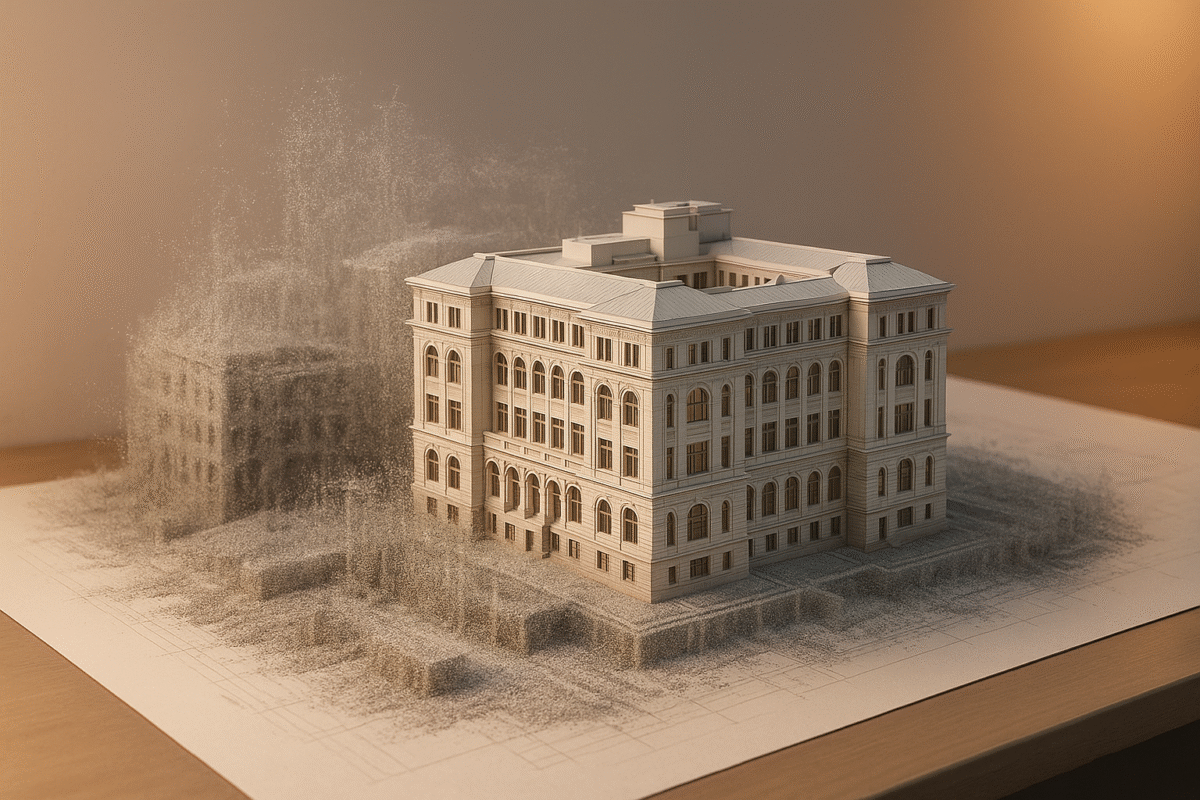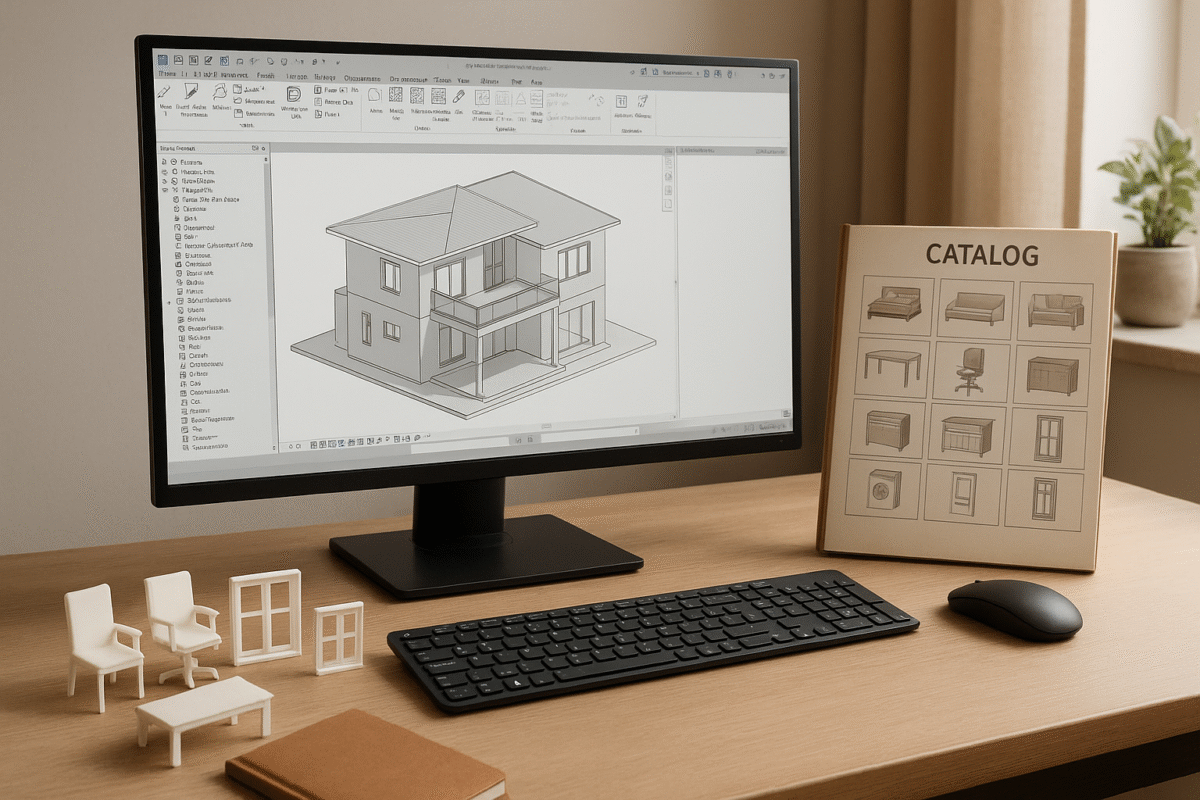5 Mistakes Small Architecture Firms Make When Growing Their Teams
5 Mistakes Small Architecture Firms Make When Growing Their Teams
Small architecture firms face unique challenges when growing their teams. Limited resources, tight budgets, and competition from larger firms often lead to common pitfalls that can hurt growth and efficiency. Here’s a quick summary of the key mistakes and how to avoid them:
- Rushed Hiring: Filling positions too quickly can lead to poor team dynamics and lower project quality. Define your needs clearly and consider temporary or remote hires to avoid bad decisions.
- Unclear Roles: Vague job responsibilities create confusion and inefficiency. Detailed role descriptions and career paths ensure accountability and better performance.
- Weak Onboarding: Poor integration of new hires leads to early turnover and low productivity. Structured onboarding, mentorship, and clear goals help new team members succeed.
- Ignoring Outsourcing: Overburdening in-house staff instead of outsourcing specialized tasks increases costs and stress. Scalable outsourcing solutions provide flexibility without long-term commitments.
- Skipping Training: Neglecting skills development leaves teams behind on technology and industry standards. Affordable training programs and internal learning initiatives keep your team sharp.
597: Team Struggles Part 2 – Why Your Team Doesn’t Care About Your Firm’s Goals (and How to Fix It)
Mistake 1: Poor Hiring Practices
When deadlines loom and workloads pile up, small firms often rush to hire, leading to regrettable decisions. This urgency can result in hiring missteps that affect project quality and disrupt team harmony for months, if not longer.
The Problems with Rushed Hiring
The pressure to quickly fill positions creates a ripple effect. When teams are already stretched thin, delays in hiring only deepen the strain, increasing the workload on existing staff and pushing them closer to burnout. This often forces firms to prioritize speed over suitability, hiring whoever is available rather than the most qualified candidate.
The fallout from a bad hire goes beyond individual performance. As Tim Burgess, Principal at TODD Architects‘ London Office, puts it:
"The biggest damage caused by someone who doesn’t fit is the effect on the rest of the team".
To avoid this, preparation is key. Before posting job listings, take the time to clearly define your firm’s needs. Establish expectations early in the hiring process and resist the temptation to cut corners under pressure.
For immediate gaps, consider temporary solutions like contract staff. This allows projects to stay on track while you carefully evaluate permanent candidates. In some cases, a contract hire may even transition into a full-time role if they prove to be a great fit.
Balancing urgency with thoughtful decision-making is essential to building a team that supports long-term success.
Balancing Cost with Skill
Small firms, especially those with fewer than 10 employees (which make up over 75% of architecture practices), often juggle tight budgets with the need for skilled talent. But focusing solely on cost can lead to bigger problems down the line.
Start by identifying the core skills your firm needs. Instead of hiring highly specialized professionals who might lack flexibility, look for candidates who can adapt to different roles as your needs evolve.
Remote hiring is another way to stretch your budget. By considering professionals in regions with lower living costs, you can access skilled talent without overspending. For example, the median annual wage for architects was $96,690 in May 2024, but hiring remotely might allow you to find equally qualified professionals at more competitive rates.
Beyond technical skills, prioritize cultural alignment and soft skills. A poor cultural fit often leads to high turnover, which can be especially costly for small firms. Use behavioral interview questions and team assessments to gauge how well candidates will integrate with your existing staff.
Involve a diverse interview panel to get a well-rounded perspective on each candidate. Including team members of varying ages, experiences, genders, and backgrounds can help flag potential fit issues before they become costly mistakes.
When in-house hiring can’t meet specialized needs, outsourcing can be a smart alternative.
Outsourcing Specialized Roles
Outsourcing is a practical way for small firms to access expertise without committing to the full-time costs of salaries and benefits. This is particularly useful for roles like BIM and CAD work, where demand can vary significantly.
Take BIM Heroes, for example. They offer outsourcing services tailored to small firms, covering tasks like 2D CAD drafting, 3D modeling, visualization, BIM consulting, and Point Cloud to BIM conversion. Instead of hiring a full-time BIM specialist who might not always have enough work, firms can tap into experienced professionals as needed.
This approach offers clear financial advantages. Outsourcing comes with flexible pricing models – whether fixed, hourly, or milestone-based – that align costs directly with project demands. It also eliminates expenses like software licenses and benefits, while giving firms access to cutting-edge tools and technologies.
Scalability is another benefit. Firms can expand their team during busy periods by bringing in outsourced specialists, allowing internal staff to focus on design and client relationships. When workloads decrease, they avoid the burden of underutilized employees .
Outsourcing also enhances technical capabilities. BIM Heroes’ professionals are skilled in leading software like CAD and Revit, enabling small firms to deliver high-quality results without additional overhead.
As Davey McEathron from Davey McEathron Architecture explains:
"The efficiencies that are built into a BIM program are one of the things we tout when we are in front of a client trying to win that business. When you show a client a 3D model and start spinning it around, it kind of blows their mind."
Mistake 2: Unclear Role Definitions
Rushing through hiring can disrupt team dynamics, but failing to define roles clearly can be just as damaging. As small architecture firms grow, every role needs to contribute to operational efficiency and uphold design quality. Without clear role definitions, confusion and inefficiency creep in, slowing projects and harming team morale.
How Unclear Roles Impact Performance
When roles lack clarity, teams often face duplicated efforts, missed deadlines, and gaps in accountability. For instance, a BIM specialist might end up handling basic CAD tasks instead of focusing on advanced modeling, while junior architects may hesitate to make design decisions because they’re unsure of their responsibilities. This confusion creates bottlenecks and leaves employees feeling frustrated.
Clients notice these internal issues too. Disorganized teams or inconsistent communication can erode client confidence. As Olly Shaw from Equal Experts highlights:
"Having a clear definition of architecture and architecture roles makes it much easier to recruit the right people into the right roles".
Blurry responsibilities can also lead to inefficiencies, like tech leads spending their time on governance tasks instead of engineering work. When skilled professionals are stuck doing tasks below their expertise, talent and resources are wasted.
By defining roles clearly, firms can recruit effectively, identify gaps, and communicate value – both internally and externally. This clarity not only reduces confusion but also strengthens client relationships. To avoid these pitfalls, small firms must establish clear and measurable role expectations.
Crafting Clear Role Descriptions
The first step to resolving performance issues is creating detailed role descriptions. These should outline tasks and explain how each role ties into the firm’s overall goals.
Start with thorough job descriptions that include the job title, primary responsibilities, specific tasks, required skills, experience, and reporting structure. For architecture firms, it’s essential to detail technical requirements and show how each role contributes to project success.
For example, instead of a vague statement like "manages BIM processes", write: "Develops and maintains 3D building models using Revit, coordinates clash detection reviews, and ensures model accuracy for construction documentation phases." This level of detail helps both current team members and potential hires understand what’s expected.
Job leveling is another critical element. Rob Green from Darwin Total Rewards explains:
"Job levelling is the backbone (within job architecture): knowing what levels you have, what they mean, and what the key differences are between levels supports Talent and Rewards management within an organisation".
For smaller firms, this could mean differentiating roles like Junior Architect (focused on design development under supervision), Project Architect (managing design phases and client interactions), and Senior Architect (leading project strategy and mentoring junior staff).
Grouping roles into job families by tasks and competencies can also help. For instance, roles might be categorized into Design (architects, designers), Technical (BIM specialists, CAD drafters), and Project Management (project managers, coordinators).
The evaluation process is where these definitions become functional. As Rob Green notes:
"Evaluation is where levelling really comes alive for the business. It’s about understanding what actually differentiates job levels – such as Software Engineer Level 1 versus Level 2".
Regularly share and review these role definitions with your team and clients to identify any overlaps or gaps.
It’s equally important to outline career paths tied to these roles. When employees see opportunities for growth, they’re more likely to stay engaged and committed. Figen Zaim from Olivier Reward Consulting emphasizes this point:
"If your employees are asking ‘How can I move to the next level?’ or ‘How can I explore sideways moves in different functions?’ and you don’t have an answer, that’s your sign you need job architecture".
Finally, keep job descriptions, evaluations, and salary ranges up to date. As your firm grows and takes on new projects, roles will naturally evolve. Regular updates ensure clarity and prevent the same confusion that unclear roles create. Clear role definitions are the foundation for smoother onboarding, better team collaboration, and long-term growth.
Mistake 3: Poor Onboarding Processes
Having clear roles and strong hiring practices is just the beginning – effective onboarding is crucial to ensure your architecture firm’s success. Even with a perfect hire, many small firms struggle to integrate new team members effectively. A rushed or disorganized onboarding process can undo all the effort spent on hiring, leading to lower productivity, subpar project outcomes, and strained client relationships.
The Cost of Ineffective Onboarding
When onboarding falls short, new hires can feel unprepared, confused, and undervalued. This can lead to early turnover – up to 20% of employees leave within their first 45 days. Those who feel undertrained are particularly at risk, with 80% more likely to quit compared to just 7% of well-trained employees. Early departures disrupt projects, overburden existing staff, and damage client trust. Replacing an employee can cost up to 20% of their annual salary, and poorly managed onboarding programs can cost companies as much as $1 million annually.
While small firms may not experience losses on such a scale, the effects on team morale and performance can be just as severe. A poorly handled onboarding process often leads to disengagement, frustration, absenteeism, and even reputational harm within the architecture community. Alarmingly, only 12% of employees strongly agree that their organization provides a great onboarding experience. Many find the process confusing (32%), disorganized (22%), or inadequate in training (52%).
How Small Teams Can Get Onboarding Right
You don’t need a large HR department to create an effective onboarding process. By focusing on structure, personalization, and setting clear expectations, small architecture firms can create a welcoming and productive experience. Firms with strong onboarding programs report up to an 82% increase in new hire retention and 70% higher employee engagement.
Here’s how small teams can make onboarding work:
- Assign a mentor or buddy architect: Pair new hires with a seasoned team member who can help them understand the firm’s culture, workflows, and daily responsibilities.
- Develop an architecture playbook: Provide a concise guide that covers design principles, key projects, software tools, roles, and other essential resources.
- Start with meaningful tasks: Involve new hires in real projects within the first two weeks to build their confidence and clarify their role.
- Set clear goals: Outline 30-, 60-, and 90-day objectives to track progress and provide regular feedback.
For senior hires, direct involvement from leadership is essential. When the principal architect or firm owner takes the time to share the firm’s vision and explain how the new hire’s expertise fits into long-term goals, it sets the tone for a successful partnership. Early career discussions can also align individual ambitions with the firm’s direction, creating a deeper connection.
Onboarding isn’t just a one-week process – it’s an ongoing effort. Research shows that up to half of all senior external hires fail within 18 months due to insufficient long-term integration. Regular check-ins at 30, 60, and 90 days allow firms to address any concerns, refine expectations, and strengthen the new hire’s role within the team.
For firms working with outsourced or remote specialists, adapting these practices is equally important. Virtual introductions, digital access to the architecture playbook, and consistent communication can help remote team members feel connected and integrated.
A well-structured onboarding process can increase new hire productivity by as much as 60%. It also fosters the personal connections that matter in architecture – nearly 70% of employees say having friends at work is key to job satisfaction. Small firms, with their close-knit teams, are uniquely positioned to nurture these relationships, creating a more engaged and high-performing workforce. Investing in better onboarding is a step toward building a team that can support long-term growth and success.
sbb-itb-0af4724
Mistake 4: Not Using Scalable Outsourcing Solutions
Small architecture firms often face a tough choice: hire expensive full-time staff for temporary needs or stretch their existing teams too thin. Scalable outsourcing offers a smart alternative, helping firms handle workload changes without overcommitting resources. Without this approach, firms risk missing out on projects, overworking their teams, and dealing with higher turnover rates.
Why Scalable Outsourcing Makes Sense
Scalable outsourcing gives firms the flexibility that full-time hiring just can’t match. By tapping into specialized expertise on demand, firms can avoid the heavy costs of permanent salaries and benefits – potentially cutting design expenses by up to 39% and payroll costs by over 40%. These savings come from lower hourly rates and reduced overhead, like office space, equipment, and employee benefits.
Delegating routine tasks such as drafting and documentation to outsourced teams allows in-house architects to focus on what matters most – building client relationships, refining designs, and managing projects. This shift not only boosts job satisfaction but also positions smaller firms to take on larger, more ambitious projects that might have seemed out of reach before.
Picking the Right Outsourcing Setup
Outsourcing isn’t one-size-fits-all. The right model depends on your firm’s needs and project pipeline:
- Dedicated teams work well for long-term or ongoing tasks, offering consistency.
- Fixed-price contracts are ideal for projects with clearly defined scopes.
- Hourly arrangements provide the flexibility to scale up or down as needed.
Additionally, outsourcing can lead to role-specific cost benefits. For example, urban planners and Revit architects can save up to 41%, BIM architects around 38%, and landscape or interior architects approximately 36%, compared to local hires.
Mistake 5: Skipping Training and Skills Development
Some small architecture firms view training as a luxury rather than a necessity, but this mindset can hold them back. Without ongoing education, teams risk falling behind on industry standards, struggling with new technologies, and losing their competitive edge. The architecture world evolves rapidly – new building codes, software updates, and design trends emerge constantly. Firms that avoid investing in their team’s growth often find themselves stuck with outdated methods, while competitors deliver faster and more precise results.
Why Continuous Learning Matters
A striking 83% of architects rely on continuing education and webinars to stay current. This goes beyond meeting licensing requirements – it’s about staying relevant in an ever-changing market.
Building codes and environmental regulations are frequently updated, and software like Revit, AutoCAD, and BIM platforms regularly release new features that can significantly boost efficiency. Without proper training, teams may waste valuable time using outdated methods.
"New technologies emerge daily. The only way to stay on top of that is to keep doing the new education classes. AIA has been instrumental in providing us with continuing education classes." – Kayla Bailey, Assoc. AIA
Clients now expect expertise in areas like smart building technologies, sustainable design, and inclusive design principles. Meanwhile, AI tools are reshaping how architects approach design and project management. Continuous Professional Development (CPD) ensures architects stay sharp and capable. This dedication to learning not only improves project outcomes but also strengthens client relationships.
For small firms looking to thrive, adopting cost-effective training strategies is key.
Training and Development Strategies
Here are some practical ways smaller firms can create a learning-focused environment:
- Tap Into Affordable Online Resources: Platforms like AIAU offer subscriptions starting at $149 for AIA members and $199 for non-members, providing access to a wide range of continuing education credits. Similarly, ATS Seminar offers courses priced between $10 and $50.
- Build Internal Learning Programs: Turner Fleischer’s TF Academy provides free workshops and courses, offering 60 sessions per semester. CEO Ellen Bensky explains the importance of fostering an authentic learning culture:
"We want presenters who want to teach and share their knowledge authentically. I want people who are there because they want to learn. If we had requirements and grades and exams, it would change the whole dynamics of the Academy." – Ellen Bensky, CEO, Turner Fleischer
- Host Lunch-and-Learn Sessions: Focus on topics that align with daily work challenges. For instance, HH Architecture’s HR Manager Carolyn Smith introduced study groups to support staff preparing for ARE exams, creating a collaborative learning environment.
- Create Mentorship Opportunities: Assign senior staff as Practice Advisors to guide junior team members. This approach provides hands-on learning and fosters stronger connections within the team.
- Allocate a Training Budget: Dedicate 1-2% of annual revenue to professional development. Encourage employees to earn certifications or attend industry events – these investments often lead to higher efficiency and fewer costly mistakes.
- Promote Knowledge Sharing: Use tools like a company intranet, team meetings, or informal mentoring to encourage employees to share what they’ve learned. When team members see how training directly improves their work, learning becomes a natural part of the workflow.
Conclusion: Building a Foundation for Steady Growth
Small architecture firms often face a delicate balancing act – pushing for design excellence while ensuring operational efficiency. As we’ve explored, achieving growth requires thoughtful strategies. Mistakes like rushed hiring, unclear roles, poor onboarding, limited outsourcing scalability, and neglected training can stall progress. However, each of these challenges comes with a straightforward solution.
Here’s a quick recap of those solutions: smart hiring brings in talent that aligns with both technical and cultural needs, clear role definitions enhance productivity, effective onboarding reduces turnover, scalable outsourcing helps control costs, and ongoing training keeps teams competitive in a fast-evolving industry.
By planning ahead and adopting flexible strategies, firms can achieve both growth and efficiency. As one expert explains:
"Scalability allows a business to grow and generate revenue without being held back by its structure or lack of resources. As a company’s sales volume increases, it can maintain or boost its efficiency".
Partnering with specialized service providers like BIM Heroes can also streamline operations and elevate design quality. Their offerings cover everything from concept development to construction documentation, delivering precise architectural drawings and models that integrate seamlessly with existing workflows. In fact, studies show that 70% of BIM users report improved project design quality, and BIM can cut project budgets by up to 20%.
Consider the success story of Michael Thompson, Principal Architect, who shared:
"BIM Heroes transformed our workflow with their expertise. Their team delivered exceptional quality on a tight deadline, & their attention to detail was impressive. They’ve become an invaluable extension of our design team".
Similarly, Sarah Johnson, Project Manager, highlighted:
"Working with BIM Heroes has been a game-changer for our firm. Their BIM consulting services helped us standardize our processes and significantly reduce coordination issues. The ROI has been tremendous".
The path to steady growth isn’t about avoiding every misstep – it’s about recognizing common challenges and putting systems in place that encourage sustainable progress. By focusing on strategic planning, adopting scalable tools, and investing in team development, firms can ensure both growth and design excellence go hand in hand.
FAQs
How can small architecture firms hire quickly without compromising on finding the right team members?
Small architecture firms can strike a balance between hiring quickly and maintaining quality by focusing on well-defined roles and seeking candidates who genuinely fit the firm’s culture and values. This approach not only minimizes turnover but also sets the stage for long-term success.
Planning ahead is crucial. Anticipate staffing needs based on project timelines and workloads to avoid the scramble of last-minute hiring. Streamline your efforts by creating clear, targeted job descriptions and using outreach methods that attract candidates with the right mix of skills and personality traits.
With a thoughtful hiring strategy, you can build a team that aligns with your firm’s growth goals and creative vision.
What are the advantages of outsourcing specialized roles for small architecture firms, and how can they do it successfully?
Outsourcing specialized roles can be a game-changer for small architecture firms. It allows them to tap into expert skills without the financial burden of hiring full-time staff. This not only cuts costs but also lets firms concentrate on what they do best, boosting both efficiency and the quality of their projects.
To make outsourcing work for your firm, start by pinpointing tasks that need specialized expertise – think drafting or 3D modeling. Partner with dependable professionals or companies that have a strong track record in the architecture industry. Be clear about your expectations for deliverables, deadlines, and communication from the outset. And don’t forget: solid project management practices are key to keeping everything aligned with your firm’s standards and objectives.
Why is ongoing training essential for small architecture firms, and what are some cost-effective ways to keep teams up to date?
Ongoing training plays a key role in helping small architecture firms stay ahead in a competitive field. It enables teams to sharpen their skills, adopt emerging technologies, and keep up with ever-changing industry regulations, all while encouraging individual and collective professional growth.
Affordable training options are widely available, such as online courses, webinars, and workshops offering AIA-approved credits. Many platforms even provide free or budget-friendly resources specifically designed for architects, making it easier for firms to invest in their team’s education without breaking the bank. By prioritizing continuous learning, your team can stay informed, creative, and ready to tackle future challenges with confidence.






